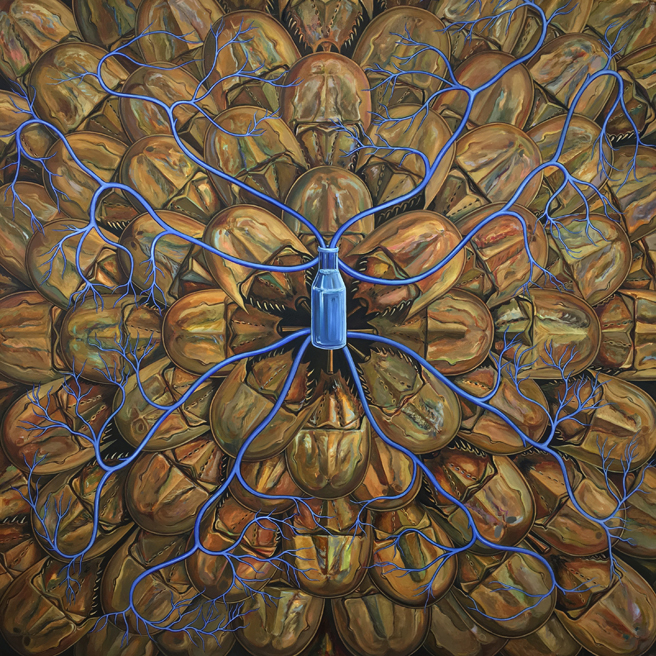Blue Blood
2017
oil on canvas
64" x 64"
oil on canvas
64" x 64"
$8000
On Exhibit
NUMU
Critical Masses, A Very Low Tide
June 17 - October 23, 2022
On Exhibit
NUMU
Critical Masses, A Very Low Tide
June 17 - October 23, 2022
I have a soft spot for Horseshoe Crabs. As children, my brother and I would explore the banks of the Piscataqua River at low tide when we visited my uncle's home in Maine. These creatures seemed magnificently alien and mysterious to us... slightly threatening with their long pointed tails upon which we were afraid of spearing our muddy feet, but also very docile and approachable, clustered quietly together along the shoreline.
As an adult I was quite surprised to learn that these prehistoric throwbacks to the Ordovician Period were playing a critical role in the Biomedical Industry. The baby blue blood of the Horseshoe Crab has the amazing ability to coagulate around bacteria, which enables it to fight bacterial infection as part of it's immune system. By live extraction of this blood, the Biomedical Industry has been able to create a Limuls Amebocyte Lysate (LAL) test which the FDA uses in the screening of drugs and surgical implants. This blue blood is more valuable than gold!
The harvesting of the Horseshoe Crab is putting pressure on it's survival, I've read that 35% of the crabs do not survive this ordeal of being captured, bled and released and for those that do reproduction rates for females is reduced. In the era of the Anthropocene, where everything is considered a commodity to be exploited, it is imperative to keep public and scientific awareness on our interaction with species like these and to make sure our actions are sustainable and their survival is safeguarded.
There's a great article by Alexis C. Madrigal, The Harvest in The Atlantic - February 26, 2014 where I began my research.
As an adult I was quite surprised to learn that these prehistoric throwbacks to the Ordovician Period were playing a critical role in the Biomedical Industry. The baby blue blood of the Horseshoe Crab has the amazing ability to coagulate around bacteria, which enables it to fight bacterial infection as part of it's immune system. By live extraction of this blood, the Biomedical Industry has been able to create a Limuls Amebocyte Lysate (LAL) test which the FDA uses in the screening of drugs and surgical implants. This blue blood is more valuable than gold!
The harvesting of the Horseshoe Crab is putting pressure on it's survival, I've read that 35% of the crabs do not survive this ordeal of being captured, bled and released and for those that do reproduction rates for females is reduced. In the era of the Anthropocene, where everything is considered a commodity to be exploited, it is imperative to keep public and scientific awareness on our interaction with species like these and to make sure our actions are sustainable and their survival is safeguarded.
There's a great article by Alexis C. Madrigal, The Harvest in The Atlantic - February 26, 2014 where I began my research.

